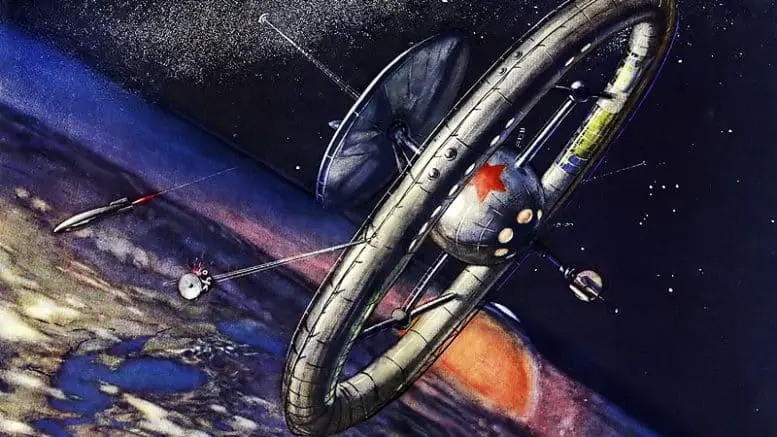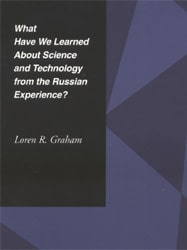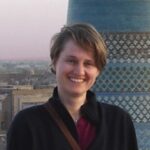One has only to look at the current debate over stem cell research in the USA to understand
In Science in Russia and the Soviet Union, Loren R. Graham presents a concise overview of the development of science and scientific institutions in Russia and the Soviet Union. This is a very readable account, interesting not only to those students interested in the history of science, but to anyone interested in the history of Russia and the USSR. Demonstrating the impact of state policy on one specific area – in this case science – this history prompts us to consider how other fields may have been affected.
An expert on the history of science in Russia and the USSR, Loren R. Graham has written several books on the subject, all easily accessible and readable. Dr. Graham is also remarkable in that he has extensive first-hand experience with Russia and the Soviet Union, as revealed in his recent book Moscow Stories, which recounts his experiences visiting the Soviet Union and later post-Soviet Russia over a period of 40 years. While there seem to be several books along these lines coming out of late, particularly from the adventurers of the 1990s, Moscow Stories has more substantial historical background to the many observations.
Below is brief list of some of the major names that the book covers as having made considerable contributions to Russian and Soviet Science. Provided are brief descriptions of each, from information taken mostly from the book, and links where you can find more information on these fascinating people. Major contributions to world science and technology have been indicated in bold.
-
Mikhail Lomonosov (1711-1765) was Russia’s first great scientist and made contributions to many fields, including chemistry, physics, mineralogy, mining, metallurgy, and optics. He also promoted the establishment of Moscow State University(founded in 1755), which is named after him.
-
-
Leonhard Euler (1707-1783) was a Swiss scientist who spent much of his career at the Academy in St. Petersburg. He is revered by both the Swiss and the Russians for the mathmatical discoveries he made while working there.
-
Daniel and Nicolaus Bernouilli (early 18th century) noted Dutch brothers and mathematicians who spent a portion of their professional career at the Academy in St. Petersburg and would inspire Russian scholars for decades. They are noted for their development of an economic principle known as the St. Petersburg Paradox.
-
Sofia Kovalevskaya (1850-1891) was the first major Russian female mathematician. Part of a generation of women benefiting from the reforms of Alexander II and the opportunity to obtain a higher education, she was also the first woman to be appointed to a full professorship in Europe (in Sweden).
-
Nikolai Lobachevsky (1792 – 1856) was a Russian mathematician who developed a variant of non-Euclidean geometry. This type of geometry would lead to other mathematical breakthroughs such as Einstein’s theory of relativity.
-
Dmitrii Mendeleev (1834 – 1907) was the primary creator of the first periodic table of elements, which greatly advanced world’s understanding of chemistry.
-
K. A. Timiryazev (1843 – 1920) was a biologist and physiologist who is most remembered in Russia as the man who planted the ideas of Darwin there. However, Timiryazev is also noted for generally advancing the state of practical biology in Russia and improving agriculture there.
-
I. I. Mechikov was a microbiologist who shared a Nobel Prize award with with Paul Ehrlich in 1908 for his work in immunology. He is noted as the first to describe phagocytosis, the process by which the body’s immune system isolates and quarantines foreign entities.
-
Nikolai Pirogov (1810-1881) is considered to be the founder of modern field surgery and one of the first doctors to make wide-spread use of anaesthetics, antibiotics, and surgical disinfectants.
-
The Pirogov Society is a Russian association of physicians. The society paid particular attention to the development of public medicine in Russia and especially to Zemstvo Medicine, a new system of medicine designed for the rural population of Russia. The society, in its last days, censured the seizure of power by the Bolsheviks and called for strikes by medical workers. A few modern societies, however, including a society of medical students, still bears the name of Pirogov, however, and doctors today still follow many of the society’s guidelines.
-
Sergei Botkin (1832-1889), is considered one of the founders of modern Russian medical science. As court physician to Tsars Alexander II and Alexander III, he introduced triage, pathological anatomy, and post mortem diagnostics into Russian medical practice. He is also noted as the teacher to the much more famous Russian physician, Ivan Pavlov.
-
Ivan Pavlov (1849–1936) was a physiologist, psychologist, and physician. He is best known as the first to describe classical conditioning, theories he developed from his famous experiments with dogs, bells, and food.
-
Trofim Lysenko (1898 – 1976) was a (now infamous) biologist and agronomist. He was appointed Director of Soviet Biology under Stalin, he rejected Mendelian genetics in favor of the hybridization theories of Russian horticulturist I. V. Michurin, turning them into the powerful political scientific movement Lysenkoism. His work is now largely viewed as fraudulent, and his contributions to science as whole are minimal. However, his power helped shape science under Stalin to the extent that opponents of Lysenkoism were imprisoned.
-
Vladimir Vernadsky (1863–1945) is known for founding geochemistry and biogeochemistry – fields that are pushing forward space exploration and the search for minerals and resources on earth. He is also known for the largely rejected theory that human cognition is a natural force inherent within the earth’s structure and was present even before mankind appeared. This force, in his theory, was housed in something called the “noosphere,” which operated alongside the biosphere and geosphere.
-
Andrei Sakharov (1921-1989) led the Soviet hydrogen bomb creation. He rose to public prominence during the Krushchev period by attempting to stop above-ground weapons testing and raising other sensitive human rights issues. He fell rapidly out of favor and was exiled to the closed city of Gorky (Nizhny Novgorod), only to later regain favor under Gorbachev. He now has a museum and center named for him in Nizhny Novgorod which also continues to draw controversy for its efforts to advance free speech and artistic expression in Russia.
-
Igor I. Sikorsky (1889-1972) designed the first four-engine fixed-wing aircraft and the first successful helicopter, of the type most commonly used today. He emigrated to the US in 1923 and founded Sikorsky Aircraft Corporation, which remains a major helicopter production and design firm.
-
Sergei Korolov (1907-1966) was a rocket designer who headed the Soviet space program, and in particular the successful Sputnik and Vostok programs, which saw the world’s first satellite launched, and the first man in orbit.
-
Mikhail T. Kalashnikov (1919-) was small arms designer, most famous for designing the AK-47, the most widely used assault rifle.
-
Vladimir Petrovich Demikhov (1916-1998) was a pioneer in the field of organ transplants in animals. He developed the first artificial heart in 1937, and performed the first world’s first heart-lung transplant in 1946, and the first liver transplant in 1948. Perhaps most remarkably, he also performed the world’s first head transplant, which resulted in the world’s first artificially created two-headed dog in 1955.
Russia and the Soviet Union contributed much to the world’s current advanced state of science and technology. Loren R. Graham’s work on the subject does much to elucidate this fact as well as to show the important connections between society, politics, and science.





